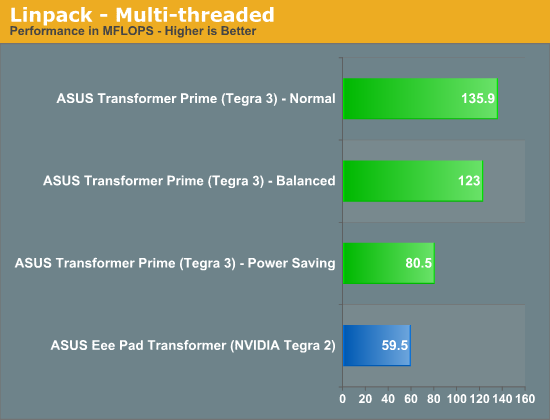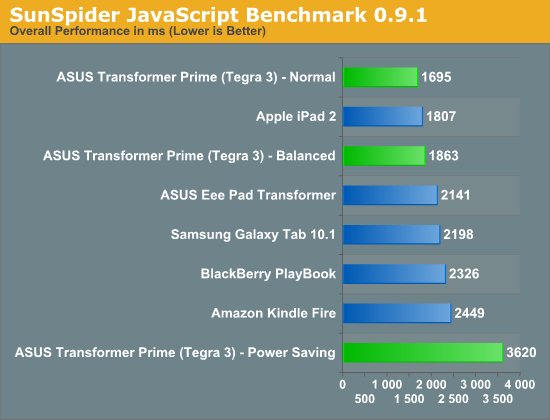ASUS Eee Pad Transformer Prime & NVIDIA Tegra 3 Review
by Anand Lal Shimpi on December 1, 2011 1:00 AM ESTCPU Performance
The big news with Tegra 3 is that you get four ARM Cortex A9 cores with NEON support instead of just two (sans NEON) in the case of the Tegra 2 or most other smartphone class SoCs. In the short period of time I had to test the tablet I couldn't draw many definitive conclusions but I did come away with some observations.
Linpack showed us healthy gains over Tegra 2 thanks to full NEON support in Tegra 3:


As expected, finding applications and usage models to task all four cores is pretty difficult. That being said, it's not hard to use the tablet in such a way that you do stress more than two cores. You won't see 100% CPU utilization across all four cores, but there will be a tangible benefit to having more than two. Whether or not the benefit is worth the cost in die area is irrelevant, it only means that NVIDIA (and/or its partners) have to pay more as the price of the end product to you is already pretty much capped.


The bigger benefit I saw to having four cores vs. two is that you're pretty much never CPU limited in anything you do when multitasking. Per core performance can always go up but I found myself bound either by the broken WiFi or NAND speed. In fact, the only thing that would bring the Prime to a halt was if I happened to be doing a lot of writing to NAND over USB. Keyboard and touch interrupts were a low priority at that point, something I hope to see addressed as we are finally entering the era of performance good enough to bring on some I/O crushing multitasking workloads.

Despite having many cores at its disposal, NVIDIA appears to have erred on the side of caution when it comes to power consumption. While I often saw the third and fourth cores fire up when browsing the web or just using the tablet, NVIDIA did a good job of powering them down when their help wasn't needed. Furthermore, NVIDIA also seems to prefer running more cores at lower voltage/frequency settings than fewer cores at a higher point in the v/f curve. This makes sense given the non-linear relationship between voltage and power.
From a die area perspective I'm not entirely sure having four (technically, five) A9 cores is the best way to deliver high performance, but without a new microprocessor architecture it's surely more efficient than just ratcheting up clock speed. I plan on providing a more thorough look at Tegra 3 SoC performance as I spend more time with a fixed Prime, but my initial impressions are that the CPU performance isn't really holding the platform back.










204 Comments
View All Comments
steven75 - Saturday, December 3, 2011 - link
But what reason can you give for not getting an ipad? Too much software selection? Too great of an ecosystem? Too much wireless video streaming to your TV? Too high of resale value? Too easy to use?Curious minds want to know!
BillyBobMcgrath - Monday, December 5, 2011 - link
How about bad value for money? For the price of a 32GB Prime you get a 16GB iPad 2. It has roughly half the specs of the Prime: only 0.5GB memory, dual core processor v.s. quad core, lower resolution and screen size (which is REALLY annoying for watching 16:9 ratio videos, which is to say more than 1/2 shows/movies you can buy/download) and lack of expansion slots.In terms of software, iPad is smoother than android but at the same time you get a very limited browsing experience with iOS. I know HTML5 is the "future" but at the present is still dominant and will be for a while.
As for apps, whilst there are less app choice, It has a good range - you may have less choice in each department than iOS but you will always find apps suitable for your needs.
Build quality, at least for the prime, is also a lot better than the iPad's. Whilst both use aluminum instead of cheap plastic, the prime uses Gorilla glass rather than normal glass.
For $500, the transformer prime gives you a much, much better product. Apple products are very good and generally blows away low-mid range non apple products but when you compare apple's products to similarly priced alternatives, they just don't deliver acceptable quality for your money.
For example, a current generation MacBook pro 15" costs £1.6K. A HP 15" with virtually identical specs costs £800. The inclusion iOS does not justify a 100% markup on a windows PC. FOr £1.6k you can buy a laptop much, much more powerful than the £2k MacBook pro. The iOS may be better but is not worth £800. Furthermore to get full functionality out of a Mac you have to buy windows for bootcamp, which is another £120. By choosing a similarly priced alternative to apple products you "miss out" on an apple OS but gain much better specd products. I don't mind paying more for a better product but I expect the quality of the product to match the price and you just don't get that with Apple.
simad57 - Friday, December 2, 2011 - link
One criticism of the original Transformer was that the charging cable was too short. Have they addressed that issue with the Prime? If not - is a USB extension cable a reasonable solution to address a too short cable or is there an issue with the about of current being pushed down the cable to charge the tablet in a shorter time than the mini usb.Stas - Friday, December 2, 2011 - link
That is a fantastic screen! I'm very surprised and impressed.user777 - Sunday, December 4, 2011 - link
1) G3 USB stick testThere were a lot of questions regarding the G3 version of the tablet.
Is there a possibility to test any G3 USB stick on the Transformer Prime dock (example 50 USD/euro G3 usb stick from Archos G9)? It would answer all these questions.
2) Skype video call test
Skype is may be the most popular video app available for a lot of Android devices. Would it be possible to make a Skype video conference call test and confirm if the Skype app works with video on Transformer Prime?
3) MX Video Player test
I really like the MX Video Player which also has full support for multi-core processors, subtitles, mkv/m2ts/mp4/... file formats, etc. Is it possible to test MX Video player too?
user777 - Sunday, December 4, 2011 - link
The possibility to play multi format video files is indeed excellent feature of the Transformer Prime.Since the video file are quite large in size playing them from a home DLNA server via WiFi is important too (example Vuse torrent client DLNA server and playing by any third party DLNA client app like Skifta, iMediaShare, Bubble UPnP). Is it possible to test the DLNA video streaming of 720p/1080p videos?
lancedal - Sunday, December 4, 2011 - link
for tablet/smartphone market, except Apple. Why? because it's so software/os dependent. With an open platform like Android/Window, it's very hard to harvest the extra resources.If you look at the PC market, the quad-core is for heavy gaming and server while the dual-core is the most generic CPU for every laptop/desktop out there. And that is with a matured market with matured OS and application.
I would doubt that Apple would go quad-core, but they are the only one can do it because they control both software and hardware. The rest? stick with dual.
ProDigit - Sunday, December 4, 2011 - link
Having a quadcore fast machine is good!However, there are not sufficient programs out there, really needing all that performance!
Most programs are smaller apps you can run with a single core running half the CPU speed!
And most games, 3D games run perfectly fine on a cortex A8 or A9 processor.
A pitty that software for Android is lacking behind!
Lucian Armasu - Sunday, December 4, 2011 - link
That's the whole Asus Transformer Prime. It can use an integrated keyboard dock, to look much like a Zenbook. The hardware is similar.kamm2 - Monday, December 5, 2011 - link
"Scrolling is rarely as smooth as I'd like it to be via the dock's trackpad. Many times the gesture just won't register on the trackpad or the trackpad will detect my two fingers but it won't scroll."We have this problem with my wife's Eee PC netbook. It is very annoying. We are looking to replace her aging notebook and will not be buying one without scroll bars on the trackpad. The probably means no Asus. The trackpad is also hyper sensitive so it makes accidental touches while typing a nightmare. There seems to be no sweet spot when adjusting the sensitivity. This is in contrast to the trackpad on her first generation Eee PC which is excellent.